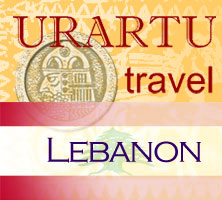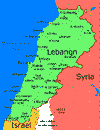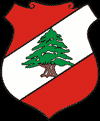About Lebanon
General Information -- Geography -- Climate -- Religion -- Language -- Population and Ethnic Composition-- Government -- Administrative Division -- Time Zone -- Currency Exchange and Credit Cards -- Capital City -- Holidays -- Airports and Public Transportation -- Traditional Cuisine -- Brief History
General Information
Coolly combining the ancient with the ultramodern, Lebanon is one of the most captivating countries in the Middle East. From Tyre’s Phoenician findings and Roman Baalbek’s tremendous temple to Beirut’s BO18 and Bernard Khoury’s modern movement, the span of Lebanon’s history leaves many visitors spinning.
With all of the Middle East’s best bits – warm and welcoming people, mind-blowing history and considerable culture, Lebanon is also the antithesis of many people’s imagining of the Middle East: mostly mountainous with skiing to boost, it’s also laid-back, liberal and fun. While Beirut is fast becoming the region’s party place, Lebanon is working hard to recapture its crown as the ‘Paris of the Orient’.
Geography
Lebanon, officially the Republic of Lebanon, is a small, largely mountainous country in the Middle East, located at the eastern edge of the Mediterranean Sea. It is bordered by Syria to the north and east, and Israel to the south, with a narrow coastline along its western edge.
Climate
Lebanon has a Mediterranean climate – hot and dry in summer June to August) and cool and rainy in winter (December to February).
In summer humidity is very high along the coast and daytime temperatures average 30°C. Winter is mild, with daytime temperatures averaging 15°C. In the mountains, summer days are moderately hot (26°C on average) and the nights cool. Winters are cold, with snowfall above 1300mm.
Religion
Lebanon is home to numerous official religious groups including five Muslim and 11 Christian denominations. Prior to the civil war, Christians and Muslims were about equal in numbers; today (due to the Christian exodus and a higher birth rate among Muslims) the latter make up around 70% of the populations.
Muslim denominations include the Shiites (the majority) who are largely found in the south, the Bekaa Valley and southern suburbs of Beirut; the Sunnis in Beirut, Tripoli and Sidon; and the Druze in the Chouf Mountains. The Maronite Christians (the largest Christian group) live in the Mt Lebanon region.
Language
Lebanese speak Arabic with different dialects or accents. All children learn the official language in school which is the classical Arabic. The Arabic alphabet has 28 letters, 2 more than the English alphabet. In addition to that, schools teach children other languages like French and English, and those are widely used at home and among friends.
Population and Ethnic Composition
Lebanon has an estimated population of 4.4 million. With nearly 90% living in urban areas (almost 1.5 million in Beirut alone), it is one of the most densely populated countries in the Middle East. An estimated 400,000 Palestinian refugees live in the country.
Government
Lebanon is a republic in which the three highest offices are reserved for members of specific religious groups:
the President must be a Maronite Catholic Christian.
the Prime Minister must be a Sunni Muslim, and
the Speaker of the Parliament must be a Shiite Muslim.
This arrangement is part of the "National Pact", an unwritten agreement which was established in 1943 during meetings between Lebanon's first president (a Maronite) and its first prime minister (a Sunni), although it was not formalized in the Constitution until 1990, following the Taif Agreement. The pact included a promise by the Christians not to seek French protection and to accept Lebanon's "Arab face", and a Muslim promise to recognize independence and legitimacy of the Lebanese state in its 1920 boundaries and to renounce aspirations for union with Syria.
The pact also stipulated that seats in the Parliament would be allocated by religion and region, in a ratio of 6 Christians to 5 Muslims, a ratio based on the 1932 census, which was taken at a time when Christians still had a slight majority. The Taif Agreement adjusted the ratio to grant equal representation to followers of the two religions.
The Parliament elects the President of the republic to a six-year term. Consecutive terms for the president are forbidden. This constitutional rule has been bypassed by ad-hoc amendment twice in recent history, however, at the urging of the Syrian government. Elias Hrawi's term, which was due to end in 1995, was extended for three years. This procedure was repeated in 2004 to allow Emile Lahoud to remain in office until 2007. Pro-democracy campaigners denounced the moves.
Lebanon's judicial system is based on the Napoleonic Code. Juries are not used in trials. The Lebanese court system has three levels - courts of first instance, courts of appeal, and the court of cassation. There also is a system of religious courts having jurisdiction over personal status matters within their own communities, with rules on matters such as marriage, divorce, and inheritance. Lebanese law does not provide for Civil marriage (although it recognizes such marriages contracted abroad); efforts by former President Elias Hrawi to legalize civil marriage in the late 1990s foundered on objections mostly from Muslim clerics.
Administrative Division
Lebanon is divided into six governorates (mohafazat, singular - mohafazah), which are further subdivided into 25 districts (Aqdya), also divided into several municipalities enclosing a group of cities or villages.
Time Zone
Lebanon Standard Time is 2 hours ahead Greenwich Mean Time(GMT+2).Daylight Saving Time changes for the Summer on the last weekend of March and for the winter, on the last weekend of October. Daylight saving Time is 3 hours ahead of Greenwich Mean Time (GMT+3)
Currency Exchange and Credit Cards
Lebanon’s currency is the Lebanese lira (LL) 9known locally as the Lebanese pound).There are a few coins (piasters) of LL50, 100 and 250 and 500 pieces still in circulation, as well as notes of 50, 100, 250, 500, 1000, 5000, 10,000, 20,000, 50,000 and 100,000.
US dollars are accepted everywhere and are as good as interchangeable with the Lebanese lira. Many places give change in either currency. The best way to access cash is through the ATMs found in all larger towns. ATMs accept credit cards or co-branded home banking cards for Cirrus, Diners Club, Maestro, MasterCard, Visa and Visa-Electron and dispense cash both in Lebanese lira and US dollars.
Capital City
Beirut is Lebanon’s heart and soul as well as the nation’s capital. Beryte, as it was originally known, was a modest port during Phoenician times. Later, it became famous in Roman times for its School of Law, one of the first three in the world, which made it a cultural centre right up until the 6th century AD. Following a long period of decline, it regained its importance as a trading centre and gateway to the Middle East in the 19th century, and its port became the largest on the eastern Mediterranean coast. The city soon became a major business, banking and publishing centre and remained so until the civil war put paid to its supremacy.
Since the war ended, rehabilitation of the city’s infrastructure has been the major focus of the both local and national governments.
Beirut is an easy city to navigate as there are conspicuous landmarks all over town.
Hamra, with its many hotels and restaurants, the Ministry of Tourism and a commercial area, is the preferred base for many travelers. To the immediate north and east is Ras Beirut, home of the American University of Beirut. To the southwest are the seaside suburbs of Manara and Raouche with a host of seaside cafes.
The Corniche runs along the coast east from Raouche to Ain al-Mreisse. Further east, past Minaret al-Hosn, home of the Phoenicia Intercontinental Hotel, is the newly-rebuilt Beirut Central District, also called Downtown or Solidere, the symbolic heart of the city. Further southeast, Gemmayazeh and Achrafiye are where Beirutis flock to sample the restaurants, bars and nightclubs on offer.
Holidays
- 1 January New Year’s Day
- 9 February Feast of Mar maroon (feast of the patron saint of the Maronites)
- March/April Easter, Good Friday to Easter Monday inclusive
- 18 April Qana Day (commemorates the massacre at the UN base at Qana)
- 1 May Labour Day
- 6 May Martyr’s Day
- 25 May Day of Resistance and Liberation (celebrates the Israeli withdrawal from South Lebanon in 2000)
- 15 August Assumption
- 1 November All Saints day
- 22 November Independence Day
- 25 December Christmas Day
Also observed are the Muslim holidays of Eid al_fitr, Eid al-Adha, Prophet’s birthday, Islamic New Year and Ashura.
Airports and Public Transportation
Beirut international airport lieas approximately 5 km south of Beirut. The red-and-white LCC bus 1 will take you from the airport roundabout (1 km from the terminal) to Rue Sadat in Hamra; bus 5 will take you to Charles Helou bus station. The blue-and-white OCFTC buses 7 and 10 also stop at the airport roundabout en route to city center. The buses operate between 5:30 am and 6pm daily, and the maximum wait is generally about 10 minutes.
Public transportation is available and buses go to nearly every town. Large cities have service taxis, taxis and buses. There are no trains or subways in Lebanon. Some towns have an open shopping area where no cars are allowed to drive or park. The yellow airport taxis are notoriously expensive. A cheaper option is to walk 1 km to the highway and hail a service taxi into town.
Beirut is well services by its network of buses, which operate on a ‘hail-and-ride’ system. There are no timetables, but buses come frequently in the day, and services stop early in the evening.
Private taxi companies usually have meters and can quote you an approximate fare on the phone. Service taxis cover the major routes in Beirut.
Traditional Cuisine
One of the best things about a holiday in Lebanon is the food. Lebanese cuisine has a reputation as being the best in the Middle East.
Fresh ingredients, including numerous types of fruit, vegetables and pulses, are plentiful in Lebanon.
Arabic or ‘Turkish’ coffee is popular in Lebanon. Freshly squeezed vegetables and fruit juices are quite widely available. Try the jellab (a delicious drink made from raisins and served with pine nuts) and ayran (a yogurt drink). Sohat, Sabil and Tannourini are considered the three best brands of Lebanese mineral water.
Alcohol is widely available in Lebanon – you’ll find everything from local beers and wines to imported whisky and vodka. The most popular alcoholic drink is arak, which is mixed with water and ice and usually accompanies meals.
Brief History
Until it gained independence in 1946, Lebanon formed part of the region known as Syria, as it shared that country’s history.
Lebanon emerged with Syria from the break-up of the Ottoman Empire following WWI. Between the wars, the country was under a French mandate and then it became fully independent in 1946. Its strategic Middle Eastern location and relatively stable, West-learning government made it a major trade and banking centre, with many western multinationals basing their Middle Eastern head offices on Beirut.
But Lebanon had a fatal flaw in its national make-up: power and control rested with the right-wing Christian part of the population, while Muslims (almost half the population) felt they were excluded from the real government. Add large numbers of displaced and restive Palestinians and the result was a recipe for conflict. In 1975 civil war broke out between a predominantly Muslim leftist coalition (allied with Palestinian groups) and Christian right-wing militias. In April 1976 Syrian forces intervened at the request of the
Lebanese president, Suleiman Franjieh, to halt the defeat of the Christian forces. An uneasy peace was foisted upon the two sides by the Syrians.
Then came more trouble. In order to protect Northern Israel from cross- border attacks
by the Palestine Liberation Organization (PLOis withdrew), the Israelis marched into Southern Lebanon in 1978 and set up a surrogate militia, the South Lebanon Army (SLA). Following UN pressure, the Israel; three months later and were replaced by an interim UN peacekeeping force (Unifil).
Meanwhile in Beirut, both the Christian and Muslim militias continued building up their arsenals. With the failure to find a political solution acceptable to all parties, fighting erupted frequently, only quashed by Syrian intervention. At the same time, Christians started demanding that Syria withdraw its troops from Lebanon.
In June 1982 Israeli troops again marched into Lebanon, this time with the stated aim of eradicating the PLO. Laying siege to Beirut, they relentlessly bombarded the Muslim half of the capital by air, sea and land for seven weeks; In August the USA arranged for the evacuation of PLO fighters to other Arab countries, and a Multinational Force (MNF) lf US and Western European troops was deployed in Beirut to protect Palestinian and Muslim civilians. After the assassination of Lebanese President-elect Bashir Gemayel
(a Christian militia leader), Israeli troops entered west Beirut. Two days later the Israeli-backed Christian militias famously massacred Palestinian civilians in Shatila and Sabra camps in this area. Bashir’s brother Amin Grmayel was elected president.
More than a year later Israeli troops finally withdrew to southern Lebanon. No sooner had they left than fighting broke out between Druze Muslim militias and Christian forces who had been deployed in the Chouf Mountains east of Beirut under Israeli protection. At the same time, fighting erupted between Lebanese army units and Muslim militia in the capital. The MNF came under repeated attack and suffered heavy casualties; it withdrew on early 1984 following suicide bombings of the US and French contingents on October 1983.
In mid -1985 the Israelis withdrew from the rest of Lebanon, except for a 60 km-long border strip, which remained under Israeli and SLA control. Over the next couple of years the country descended into more chaos as rival factions within both the Christian and the Muslim camps fought each other, and Iranian-backed Muslim fundamentalists (the Islamic Jihad) resorted to taking foreigners hostage. At the request of the then prime minister, Selim al- Hoss, Syrian troops returned to west Beirut in February 1987 to end fighting between rival Muslim militias; The Syrians slowly brought the Muslim areas of Lebanon under their control.
At the end of his term, on September 1998, President Gemayel appointed a transitional military government led by General Michel Aoun to succeed him. Aoun disbanded the Christian militias and then launched a “war of liberation” against the Syrians in Lebanon. Following fierce fighting Aoun was defeated and sought refuge in France in August 1991. In the meantime, a majority of Lebanese MPs met in Taif, Saudi Arabia, to sign an Arab- brokered “accord for national reconciliation”. The MPs elected a new President, Rene Mauawad, who was assassinated 17 days later. He was replaced by Elias Hrawi, a moderate Maronite Christian who had good relations with Syria.
With the help of the Syrians the Lebanese army took control of Beirut and by late 1991had spread its presence to most Lebanese areas. By early 1992 all surviving foreign hostages had been released and Syrian troops began withdrawing from the Beirut area.
In August 1992 parliamentary elections were held in Lebanon for the first time on 20 years, and Muslim fundamentalists of the Iranian-backed Hezbollah (Party of God) won the largest number of seats. A few months later the cabinet resigned and Rafiq Hariri was appointed prime minister.
As the new cabinet began rebuilding Beirut’s infrastructure and rehabilitating the country, the security situation remained tense in southern Lebanon. Israeli forces continued to attack the South during 1991 and 1992 as Skirmishes between Israeli soldiers in the border strip and the Hezbollah fighters increased in frequency.
After Hezbollah fighters killed seven Israeli soldiers in July 1993, Israeli forces launched week-long air, sea and land bombardments on some 80 villages in Southern Lebanon, killing 113 people and causing more than 300,000 civilians to live for safer areas.
Trouble flared up again in April 1996 when Israel mounted a wave of air strikes on Hezbollah positions in the Southern suburbs of Beirut and Southern Lebanon. After Hezbollah responded, the Israelis launched another campaign, “OPERATION GRAPES OF WRATH”. There action attacked wide condemnation when media reported that 102 refugees sheltering in a UN base at Qana had been massacred when the base was bombed by the Israelis.
In late May 2000, the Israelis and the SLA withdrew from Lebanon, leading to great rejoicing throughout the region. Nevertheless, relations between the two countries remained tense and many Lebanese fear that their country will once again be dragged into the volatile and seemingly irresolvable conflict between the Israelis and the Palestinians.
In February 2005, a tragic even acted as a catalyst for a major historical upheaval. The former prime minister and popular benefactor, Rafiq Hariri, was killed in a car bomb in Beirut. Though the Damascus denied any involvement, the Syrians were popularly blamed and huge anti-(and some pro-) Syrian demonstrations followed. The public reaction in turn triggered both the withdrawal of Syrian forced from Lebanon (ending a 29-year military presence) and the eventual downfall of the government later that year. Following elections in May and June 2005, and anti-Syrian allegiance led by Saad al Hariri, (the son of the assassinated Rafiq Hariri) won a majority in parliament –and for the first time in 15 years, members apposed to Syrian influence outnumbered the pro-Syrians. Fouad Seniora (a Hariri ally) is currently prime minister, and, all though the Syrian-backed Emile Lahoud remains as president, pressure is mounting on him to resign. For the first time also, a member of Hezbollah joined the new cabinet. The government has pledged to continue the reform and development initiated by Rafiq Hariri.
In the meantime, political jockeying and continuing Syrian interest in the country, allied with deeply rooted corruption and ever-simmering sectarian tensions still far from guarantee as smooth path forward for the country.



